Taking a break from the usual photo-stream, I've decided to participate in an initiative which the travel blog BootsnAll has created. Starting November 1, they launched a project called 30 Days of Indie Travel. They’re inviting bloggers from around the world (including you!) to join us in a daily blogging effort reflecting on our past travel experiences. Each day, they'll post a new prompt on BootsnAll articles. Bloggers can follow the prompts as strictly or loosely as they like, interpreting them in various ways and responding via text, photos or video posted on their own blogs. Today's theme: EarthAt what point in your travels have you felt most in tune with the Earth? Share a story of how you interacted with the local environment or nature.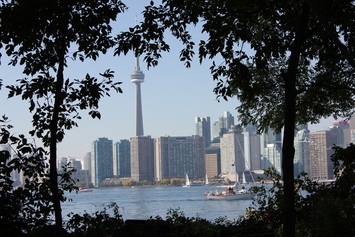 Toronto skyline from Centre Island This question seems fairly easy for me to answer (however it's such a BIG topic, this post will end up quite lonnnnnnng), as I positively feel the most in tune with Earth when in nature itself. Now there's possibly different levels of how in tune you can be.. The further away from human civilization, the great that level gets. I should probably start off by mentioning that I have lived in cities (of all sizes) for the longer part of my life. Just in the past 6.5 years I've been living in Toronto - Canada's largest city, at 3.5 million (close to 7 million with it's suburbs). I can't say I hate it, to be quite frank. The accessibility to culture, food, arts, festivals, you name it.. and there's a decent number of forested areas to hike through, one of the world's largest lakes to sail on, decent bike trails. Those are necessary elements in a city of this size, mind you.. for people like me. People who have an unquenchable thirst for nature.
Now going camping gets me goin. I love it. From simple lot based camping which is never more than a 30 mins drive away, basic but meets minimal needs and desires. Then within a close distance of 300 kms (relatively speaking in Canada, I know you can cross several European countries in that span) you can end up in the heart of Algonquin Park - a park that's 7725 sq/km (almost the size of Jamaica, and Bigger than Trinidad and Tobago!) of wilderness, complete with forests, hundreds of lakes, and rivers - on top of the crazy abundance of animals (ie moose, bears, foxes, woodpeckers, etc etc). It's a nature lovers paradise. This is what I grew up with... it's what I know and can relate to.
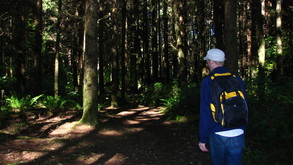 Hiking in Stanley Park, Vancouver, Canada Travelling brought me closer to even more types of nature. From my first experience hitchhiking across Canada back when I was 16, seeing the prairies (incredibly surreal how FLAT it really is... endlessly!), to the rugged Rocky Mountains, to the Rain forests of the west coast along the Pacific Ocean. This really got me in tune, but now hungry for more.
I'd have to say my favorite things on earth, that have made me feel most in tune, are places in the mountains, in the jungle, on a tropical island, or by the sea, and each of these places should be teaming with wildlife. Not to say that tundra, deserts, farmland or anything else is less a part of the Earth, but I really just don't connect in the same way.
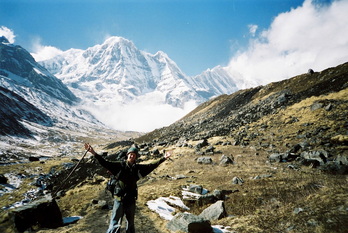 Almost there - Annapurna Base Camp, Nepal I've hiked several mountain ranges, and lived in Banff National Park on a couple occasions which gave me endless access to unspoiled wilderness, full of elk, bears, endless forests, glaciers and of course mountains in need of a climb.. however, I would have to say my time hiking in the Himalayas of Nepal brought me the closest to nature out of the lot. There would be long days without seeing any signs of civilization. Hiking up and down foothills, crossing raging rivers on rickety bridges, through forests, to hilltops that surpassed the tree line. Sadly there's not much wildlife to be seen in those parts, outside of the occasional hawk, but the ruggedness and raw beauty were unparalleled. We would fill our bottles with waterrun off from snow-peaked mountains, fill our lungs with the crisp, fresh air, and stop to listen to the sounds of nothingness. The reward was supposed to be making it to Base Camp, but as with all journeys: " It is good to have an end to journey toward; but it is the journey that matters, in the end" ~ Ursula K. LeGuin .
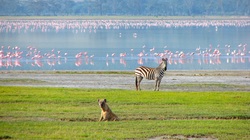 Life in the Ngorogoro, Tanzania I often fall into a natural meditative state any time I'm in one of these locations. From Ngorogoro, the incredible lush volcanic creator of the Serengeti in Tanzania, which is erupting with wildlife of all kinds, to the greenest rain forests and jungles, Wildlife is always a big part of feeling connected for me.
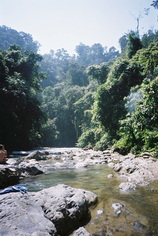 Deep in the jungle, Indonesia The lushest jungles I've been to were probably the ones in Sumatra, Indonesia. I had just been visiting an Orangutan rehabilitation centre, and then went on a 2 day hike into the jungle to see them in the wild. On the trek we saw long tailed howler monkeys, massive monitor lizards, tortoises, and to our fantastic luck a family of 3 Orangutan (an adult with two adopted young ones). Honestly, that moment was zen, and it was so liberating feeling that deep into the natural world, being surrounded by life on every square inch of every surface that could sustain it! This to me is living.. this is life in all it's glory.
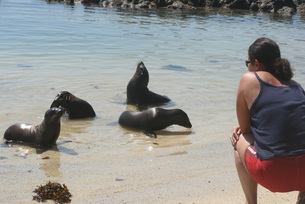 Sea Lions in the Galapagos Now when it comes to the hybrid of wildlife, oceans and islands, I feel it's a very hard toss up between which I would consider the closest I felt to nature, and the Earth. The toss up is between the Galapagos Islands of Ecuador, and the many archipelago which lay on the edge of Antarctica. Both are overflowing with their own unique wildlife. One tropical, one polar (though they both have penguins - maybe that's the appeal?). The animals that inhabit these areas have not been tainted by human colonization. Of course there was hunting which happened when first discovered, though both are now protected areas. The animals own the land, and as a visitor to either, you are strictly instructed not to disturb their daily routines (ie don't feed, don't
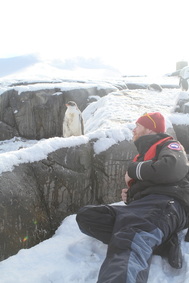 "Chillin" w/ Penguins, Antarctica touch... don't eat them). If the animals care to come inspect you, that's a different story.. I've had penguins playing with some ski tags on my snow pants, and hopping around me like children to a circus clown, but even with that proximity, you must always remember, we are visitors to their land. These places are perhaps windows to what most of the world looked like before we colonized almost every inhabitable space. You will never hear silence like you do in these places, you will never smell air so fresh, see animals so natural, or feel so in tune with the Earth as you will in these special spots.
These are my happy places, where I can truly connect with nature.
These are where I truly feel at one with Mother Earth.. she's a damn sexy MILF.
Taking a break from the usual photo-stream, I've decided to participate in an initiative which the travel blog BootsnAll has created. Starting November 1, they launched a project called 30 Days of Indie Travel. They’re inviting bloggers from around the world (including you!) to join us in a daily blogging effort reflecting on our past travel experiences. Each day, they'll post a new prompt on BootsnAll articles. Bloggers can follow the prompts as strictly or loosely as they like, interpreting them in various ways and responding via text, photos or video posted on their own blogs. Today's theme: MistakesEveryone makes mistakes. We forget to ask for Coke without ice in Mexico and spend the rest of the trip in the bathroom. Or we arrive at the airport for a 7pm flight only to realize the flight left at 7am. Tell us the story of your worst travel mistake.Many time travelling you find yourself in situations where you may not know how to handle them due to either cultural differences, forgetfullness, or perhaps just that you've never been placed in a situation such as this before. The results of how you handle these situations dont always end up going as smoothly as one may have hoped. You could wind up sick, injured or even find yourself in a bit of trouble. This could be looked as as making a mistake, or as I prefer to see these situations: an opportunity to learn and to grow.
I'm sure I've found myself in countless of these situations, though thankfully have never found myself in 'too much' trouble as a result. Be it getting sick, mugged, or just plain lost, I've taken each of these situations with stride and only tried to further my understanding and awareness of the world around me. Let's take a look at some examples.
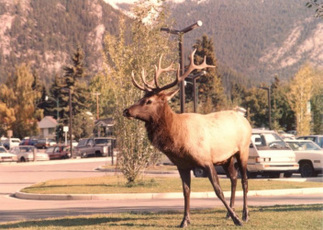 A male elk in Banff National Park WildlifeAs per the name, wildlife is just that... wild. Many people travelling to an area which has an abundance of wildlife, some which may even find themselves in parks or other public areas, often forget that simple element. Familiarizing yourself with safe practices of how to treat the wildlife is extremely important. The animals may often be accustomed to having tourists tramping around them, they still have their own natural defence instincts in tact, and may burst out at an unsuspecting tourist trying to take pictures or get close to them. I had a very good learning experience, which actually put my life in jeopardy, while travelling to Banff National Park, in Alberta, Canada. The park is teeming with wild Elk, who migrate through the city due to the abundance of fresh cut grass to graze on in the parks there. Many visitors to the park assume the animals have been domesticated because of their presence there. Though in this situation, I did not approach the animals, nor do anything to aggravate them, other tourists had been taunting a particular pair, mother and baby, throughout the day. At one point I found myself laying in the park, face to face with the protective mother, who had already reached a breaking point from the earlier taunting. With the wrong movement of my own part, the elk turned on me, chasing me down and tackling me from behind. Luckily, this life threatening situation was quickly diffused by many locals who had been watching the situation unfold, and chasing it off once the attack had begun. I was quite fortunate, but should have been more apprehensive as the majestic animal approached. This situation could have been averted entirely had I been more aware of the threat that approached me. For a more detailed account of this story, check out my blog entry here.
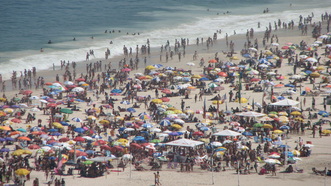 Crowded beaches of Rio de Janeiro during Carnival Children
Seemingly the most innocent, our hearts often go out to seeing children who live on the streets in many countries around the world. This is not always the case, however. Often children who have been living on the streets for a while end up falling into street gangs, or working for larger crime rings, just as a means of survival. Be it on the crowded beaches of Rio de Janeiro, the busy streets of Berlin, or in the slums of India, this is something which happens all over the world. One of the most classic examples would be the children, sometimes referred to as "cardboard kids", who circulate popular landmarks throughout Europe, such as the Colosseum in Rome, who will send one child face to face with an unsuspecting tourist. With their hand outreached holding a piece of cardboard, they will confront the tourist pushing the cardboard against their chest, crying and yelling in their local language. While this distraction is happening, a group of other children will run behind the tourist, pickpocketing them for all their worth. By the time the confused tourist realizes that something isn't quite right, and that they're being mugged, the group of children will have disbanded in all different directions, making it impossible to chase them all down - at most only catching up to one of them.
Something similar started happening to me in Barcelona, Spain, while walking back from a bar late one night with a small group of travellers I had met at my hostel. A child, no more than 10 years old, approached and kept asking me to "Dance mister, dance with me". He would attempt to push himself up to me. Luckily, my old baggy pants had deep pockets with closed buttons at the top, and I very quickly realized what was happening, and shoed the child away. Relentless, however, he kept insisting, right up to the point that I felt their little hands trying to open my pockets. Pushing the child hard on to the ground, I heard a scream from behind me, as the desperate children took a more aggressive approach and jumped on one of the Australian girls I had been walking back with, attempting to snatch her purse away! We fended the children off showing our superior strength while huddling together. Thankfully the children did not come baring arms, but the lesson learned here was to walk in greater numbers late at night when passing through areas which may have this as a problem. Ask your hostel or hotel which areas are safe and which are known more for this type of threat, before venturing out at night.
 Fruit vendor in Varanasi, India Sickness
It seems like something almost inherent with travelling, though it can often be avoided, or at least set to a minimum, if you practice preventative measures. I have spent several vacations where for a few days, the only sites I saw were my bedroom ceiling, and the porcelain throne. This is often caused by eating food which was poorly prepared, or grown in unsanitary conditions. Eating vegetables which grow on the ground in countries with very basic farming practices can bring with them many diseases and viruses which will make you sick. It's best to stick to eating fruit which grows up in trees, as there is much less of a risk of having the contaminants, such as diseased manure, coming in contact with the fruits. Eating a street stalls is also one of the best parts of travelling, but can bring with it the worst outcomes if not cooked properly. Make sure that you can see your vendor properly heating the food in front of you. If it comes out luke warm, it's probably going to make you sick. Another trick I've learned is to keep my nails cut quite short. This lessons the possibility of getting dirt and germs stuck under your nails, reducing the risk of those entering your body through contact with your mouth, or face. Insect repellant, of course, is also a key factor in keeping away the pesky, disease carrying mosquitoes which are prominent in most warm climates around the globe. Having had my share of sicknesses, these have become staple rules to follow when travelling abroad.
These are just some of the lessons learned from making these simple 'mistakes' in my journeys, though for the most part, I was quite fortunate, and came out unscathed and with some good stories to tell, but one may not always be so lucky. Use common sense, and learn from these situations - and then post a blog about it so the rest of us can learn too ;)
No visit to the Serengeti would be complete without a day trip down to the Ngorogoro Crater. It is a Mecca of wildlife. Like a magical paradise where almost all animals from the Serengeti come to feed (except Giraffes.. they can't navigate down the steep slopes). One of the animals found here in the most impressive numbers is the pink flamingo, which fill the three soda lakes found within the crater. Truly a spectacle in itself, and one of the few places in the Serengeti you will see them in these numbers.
The Great Frigate Birds are large black sea birds of the South Pacific, South Atlantic and Indian Ocean regions. They can measure up to a meter in length and primarily feed on fish at the surface of the sea, mostly consisting of flying fish. The most notable feature of these interesting birds are the males inflatable red chests. As with many bird species, the males use this to attract female counterparts. You will find these Frigate Birds all over the Galápagos Archipelago, concentrating themselves on high cliff walls and soaring gracefully overhead.
The Galápagos Green Sea Turtle is believed to be endemic to just the area surrounding this archipelago in the Pacific Ocean. They have been difficult to track, as with most sea turtles, due to their migrations and deep submersion in the ocean. They are however on the endangered list, and efforts to assist their population have so far been proving unsuccessful.
Even with lower numbers, it's not uncommon to encounter some of these beautiful creatures while snorkeling as they gracefully glide along the seas currents below you.
Galápagos Sea Lions are a species, like most species found in the Galápagos archipelago, native only to the islands and no where else in the world. They are one of the most abundant species on the islands, thus making them easy to spot almost everywhere, both on land, and while snorkeling off in the sea. This young pup was part of the welcoming committee when I arrived to the islands, and awoke from his pup nap under a bench to wink hello and let out a little pup bark.
Maybe one of the most unique animals to be found in the Galápagos Islands, is the Marine Iguana. The reason it is so unique, is that it has ability to dive down, up to 10 meters (30 feet), just to forage sea weeds and algae off the ocean floor. No other modern lizard has these marine abilities. They are found in great abundance in the Galápagos archipelago, though still vulnerable to environmental and human impacts. You'll often see them warming their cold-blooded bodies after a dive in the cooler sea waters on hot, black lava rocks which litter the shoreline of almost every island.
Seeing species as unique as this in great abundance is one of the most incredible feelings of being on the Galápagos islands. Not every visitor necessarily shares this viewpoint, however:
"The black Lava rocks on the beach are frequented by large (2-3 ft), disgusting clumsy Lizards. They are as black as the porous rocks over which they crawl & seek their prey from the Sea. I call them 'imps of darkness'. They assuredly well become the land they inhabit."
~ Charles Darwin
Galápagos Penguins are the only penguins known to survive North of the Equator. They are of the same family as those found in South America and Africa along their southern coasts. Spending most of their time in the cooler waters and currents, it is always a special treat to be able to see one floating along the water's surface, or even more excitingly, hopping around the islands' rocky shore line. Though this species is considerably small, the third smallest in the world, it is still quite fast and agile, given the high volume of predators they must face on and around the islands.
The Galápagos Hawk is endemic to the Galápagos Islands. Though there are some similar relatives on North and South American mainland, this species has traits entirely unique to this archipelago. In their maturity, the adult hawks are a dark blackish-grey, though in their youth they have a very different brown speckled appearance to assist with their camouflage until then reach an age where they can more easily fend for themselves. Near the top of the food chain in their division, they are an apex predator, eating anything that they can easily lift or tear apart with their powerful talons and beak. There is currently little concern for the extinction of this magnificent bird.
The giant tortoises of the Galápagos islands are one of the most important creatures found here, by means of man's understanding of the significant importance this archipelago holds. Not only is the name "Galápagos" derived from the spanish word galápago, meaning tortoise, these prehistoric looking animals were also a fundamental influence to Darwin's theory of evolution. Finding various species on 7 of the islands, there are distinct difference between each, which helped them adapt to the geographical differences of the islands. Even on the same island you may find low-land Tortoises with saddle shaped shells and long necks, compared to their high-land relatives who have larger shells and shorter necks. These harmless creatures were once hunted to the brink of extinction, but now with assistance from the Darwin Society, they have been bred back to sustainable populations and reintroduced into the islands in full abundance.
|










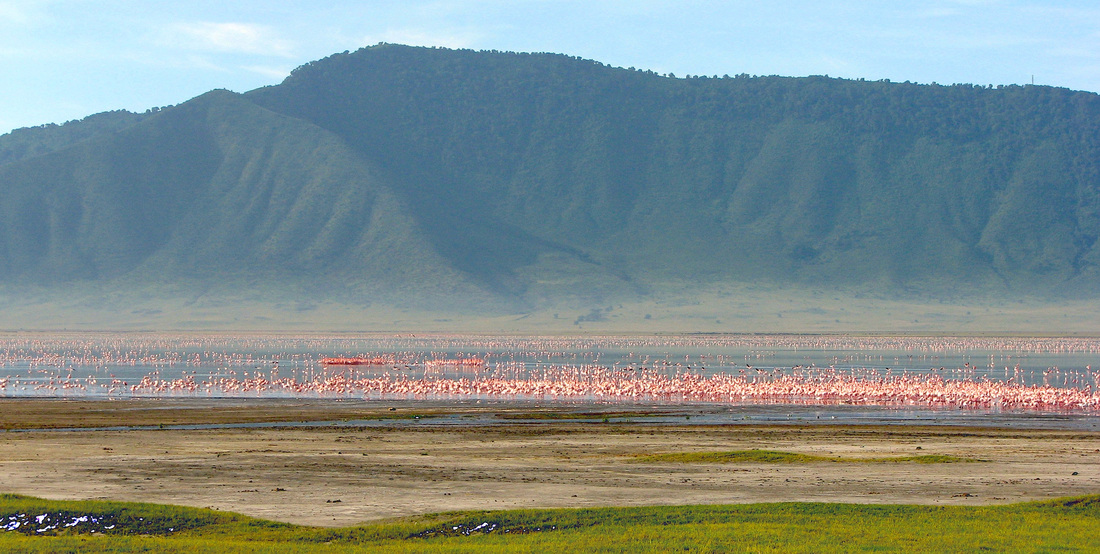
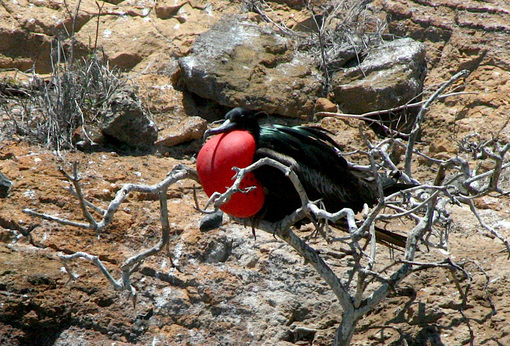
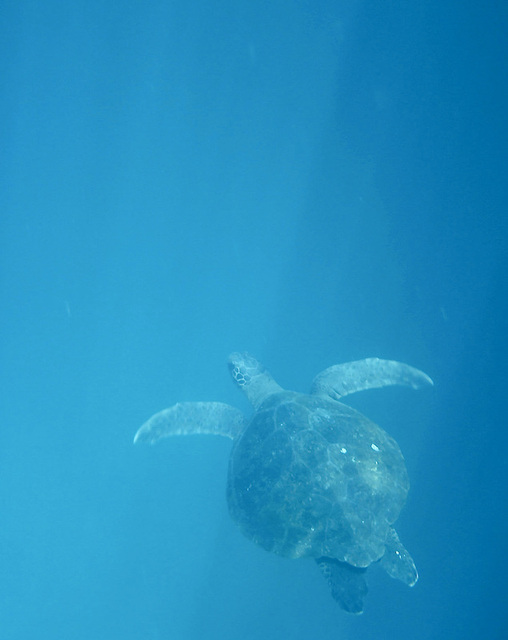
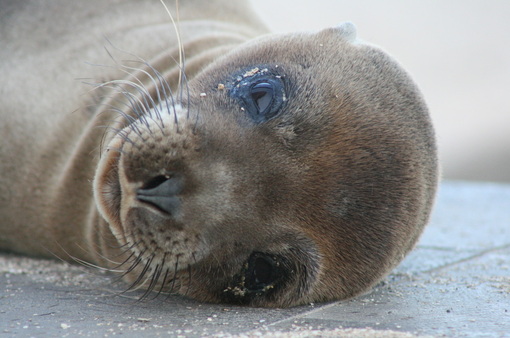
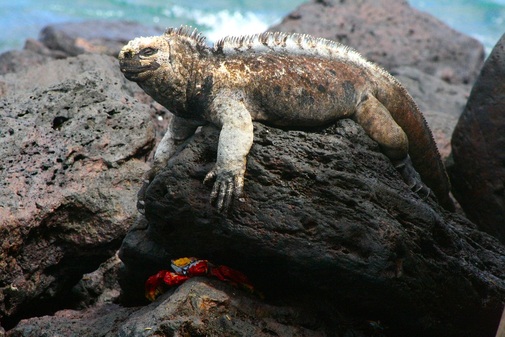
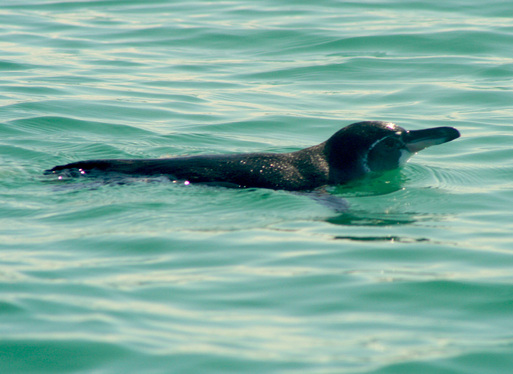
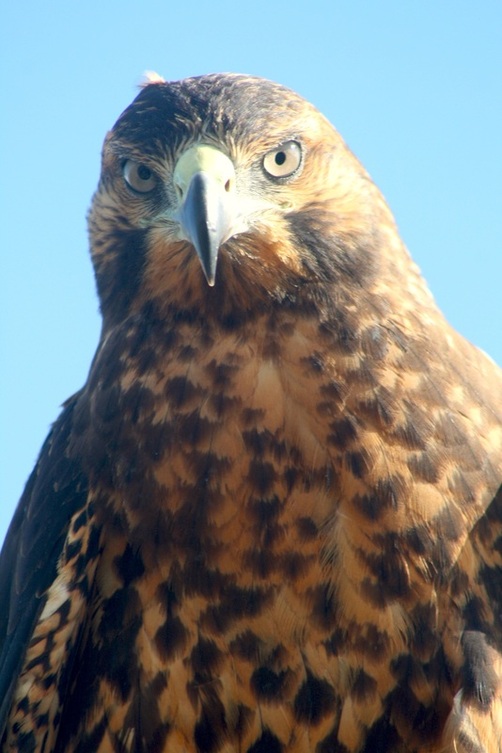
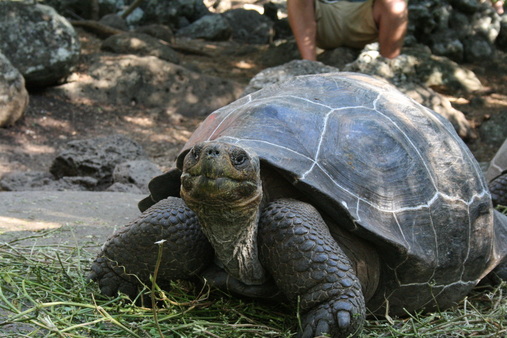
 RSS Feed
RSS Feed

